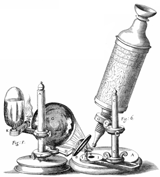மரபணுக்கள் உண்மையானவை.




 Hugo de Vries, Carl Correns and Erich von Tschermak-Seysenegg were the three scientists who rediscovered Mendel's laws in 1900. They were all working independently on different plant hybrids, and came to the same conclusions about inheritance as Mendel. Robert Hooke was one of the first scientists to describe a cell. Theodor Schwann redefined the cell as a living unit.
Hugo de Vries, Carl Correns and Erich von Tschermak-Seysenegg were the three scientists who rediscovered Mendel's laws in 1900. They were all working independently on different plant hybrids, and came to the same conclusions about inheritance as Mendel. Robert Hooke was one of the first scientists to describe a cell. Theodor Schwann redefined the cell as a living unit.
Robert Hooke (1635-1703)

Robert Hooke was born in Freshwater, England, on the Isle of Wight. Hooke was educated at Westminster, and in 1658, attended Christ Church at Oxford University. Presumably he paid for his education with some money he inherited on the death of his father. At Oxford, he met Robert Boyle who became his patron. Boyle hired Hooke to work in his laboratory, and also sponsored Hooke for membership in the Royal Society of London.
The Royal Society was started for the purpose of discussion and promotion of subjects in natural sciences. Members gathered on a regular basis, and it was at one of these meetings in 1663 that Hooke showed them the power of his newly designed microscope. In 1665, Hooke published Micrographia which contained drawings and descriptions of all sorts of material he examined under his microscope including the famous cork cells. In the same year, Hooke became professor of geometry at Gresham College, a post he occupied until his death.
Hooke was a practical and theoretical genius in almost all fields of science. Long before Darwin, Hooke recognized that fossils were remains of ancient life, and were historical life records. He was mechanically adept, and invented and improved many useful instruments besides the microscope. He invented the conical pendulum, spiral springs used in watches, the quadrant, the Gregorian telescope and the air pump used by Boyle for his experiments on gases. Hooke also designed (though never built) the steam engine, and described a working telegraph system.
As a mathematician, Hooke worked on the problem of gravity and planetary orbits. He fought with Sir Isaac Newton over the origin of the inverse square law of gravity — Hooke accused Newton of having stolen the idea from him and often engaged him in very public and very loud debates.
After the Great Fire of 1666, Hooke was chosen to design New Bethlehem Hospital in London, better known as Bedlam. He also designed a number of private houses in London.
No known portrait of Hooke exists. He was described as a lean, ugly man, which may be a reason why he never sat for his portrait. Hooke died in London in 1703 at the age of 68.


Theodor Schwann recognized that eggs, ova, are cells. In 1841, sperm were classified as cells when they were seen developing from testis cells.

What is the largest single cell in existence?
 குழந்தைகள் தங்கள் பெற்றோர்களை ஒத்திருக்கின்றன.
குழந்தைகள் தங்கள் பெற்றோர்களை ஒத்திருக்கின்றன. மரபணுக்கள் ஜோடிகளாக வரும்.
மரபணுக்கள் ஜோடிகளாக வரும். மரபணுக்கள் கலப்பது இல்லை.
மரபணுக்கள் கலப்பது இல்லை. சில மரபணுக்கள் ஆதிக்கம் செலுத்துகின்றன.
சில மரபணுக்கள் ஆதிக்கம் செலுத்துகின்றன. மரபணு பாரம்பரியம் விதிகளைப் பின்பற்றும் .
மரபணு பாரம்பரியம் விதிகளைப் பின்பற்றும் . மரபணுக்கள் உண்மையானவை.
மரபணுக்கள் உண்மையானவை. அனைத்து செல்கள் முன்பே உள்ள செல்களிலிருந்து எழுகின்றன.
அனைத்து செல்கள் முன்பே உள்ள செல்களிலிருந்து எழுகின்றன. பாலியல் செல்களில் ஒன்று, மற்றும் உடல் செல்களில் இரண்டு தொகுப்பு குரோமோசோம்கள் உள்ளன.
பாலியல் செல்களில் ஒன்று, மற்றும் உடல் செல்களில் இரண்டு தொகுப்பு குரோமோசோம்கள் உள்ளன. சிறப்பு குரோமோசோம்களே பாலினத்தைத் தீர்மானிக்கும்.
சிறப்பு குரோமோசோம்களே பாலினத்தைத் தீர்மானிக்கும். குரோமோசோம்கள் மரபணுக்களைச் சுமந்திருக்கும்.
குரோமோசோம்கள் மரபணுக்களைச் சுமந்திருக்கும். குரோமோசோம் துண்டுகளின் பரிமாற்றம் நிகழும் போது மரபணுக்கள் சிறிது மாற்றியமைக்கப்படுகின்றன.
குரோமோசோம் துண்டுகளின் பரிமாற்றம் நிகழும் போது மரபணுக்கள் சிறிது மாற்றியமைக்கப்படுகின்றன. பரிணாம வளர்ச்சி மரபணு வேறுபாடுகளின் பரம்பரை உடைமையிலிருந்துத் தொடங்குகிறது.
பரிணாம வளர்ச்சி மரபணு வேறுபாடுகளின் பரம்பரை உடைமையிலிருந்துத் தொடங்குகிறது. மெண்டலின் விதிகள் மனிதர்களுக்குப் பொருந்தும்.
மெண்டலின் விதிகள் மனிதர்களுக்குப் பொருந்தும். மெண்டலின் மரபியல் மூலம் மனித சுகாதாரம் மற்றும் நடத்தையை பற்றி முழுமையாக விளக்க முடியாது.
மெண்டலின் மரபியல் மூலம் மனித சுகாதாரம் மற்றும் நடத்தையை பற்றி முழுமையாக விளக்க முடியாது.